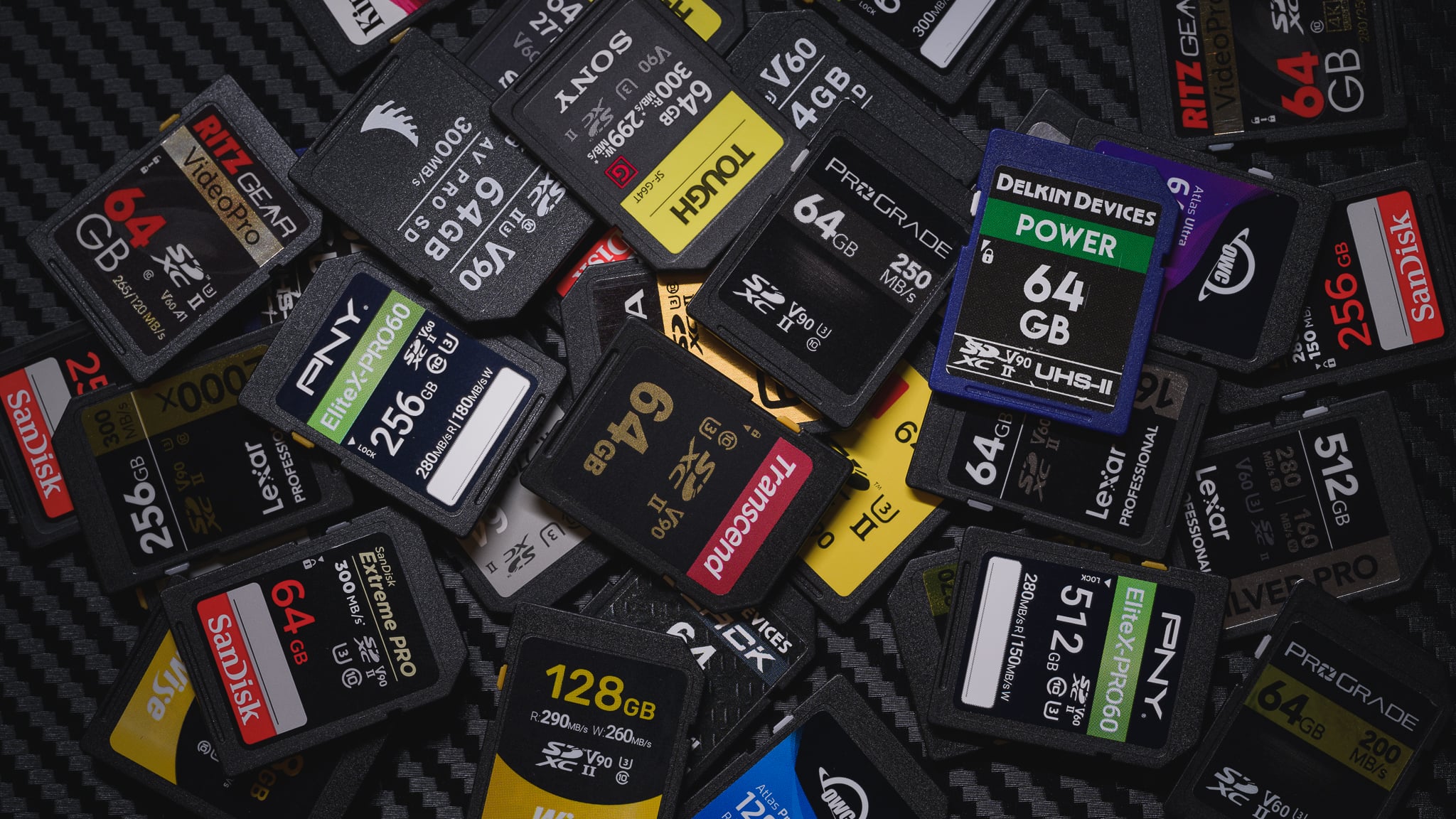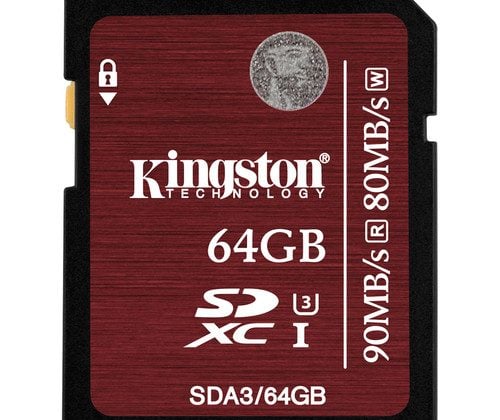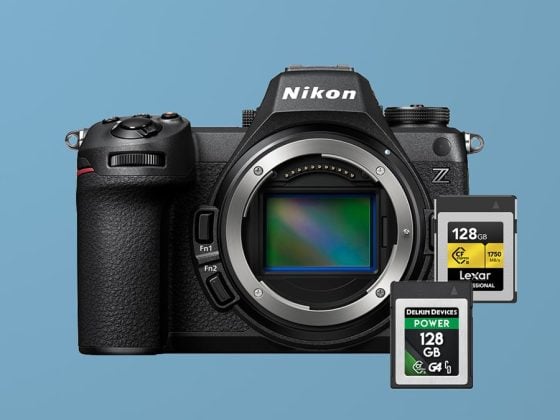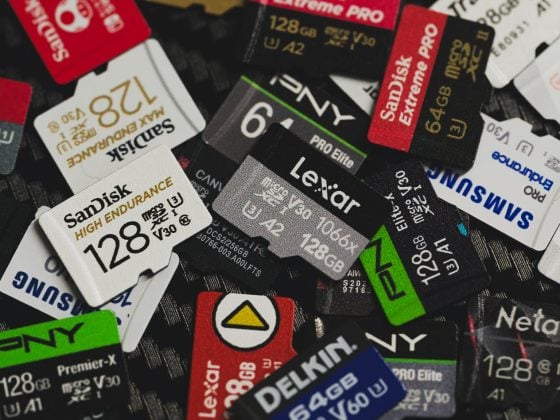Memory card brands don’t always list the real-world speeds of the cards on their packaging or on their cards. In this guide, we’ll look at some benchmarks to see the real USB read and write speeds and how they perform with various cameras. This should help you find the best SD memory cards for your needs.
SD Memory Card Benchmarks
The chart presents data from USB performance tests conducted with a UHS-II Prograde USB-C memory card reader connected to a Windows 11 machine with USB 3.2 2×2, using the AJA System Test for benchmarking.
The results can be organized by speed or class. Remember that real-world speeds might differ based on the specific reader or computer used when testing your SD memory cards. Even a bad or incorrect cable can influence the speeds.
You’ll notice some UHS-I SD cards now advertise as being able to hit 200MB/s write speeds, but this is only true for the latest readers with the supported hardware.
| SD Memory Cards | Review Links | Speed Class | Rated Write | Rated Read | Rated Sustained | Tested Write | Tested Read | |||
|---|---|---|---|---|---|---|---|---|---|---|
| SD UHS-II V90 | UHS-II | Hide | ||||||||
| Sandisk Extreme Pro V90 32-512GB | Sandisk Extreme Pro V90 UHS-II Review | UHS-II | 260 | 300 | 90 | 268 | 293 | 90 | https://geni.us/S6WrhEt | |
| Lexar 2000x V90 32-256GB | Lexar 2000x V90 UHS-II Review | UHS-II | 260 | 300 | 90 | 228 | 256 | 90 | https://geni.us/wV6t67K | |
| Transcend v90 | UHS-II | 180 | 285 | 90 | 175 | 263 | 90 | https://geni.us/739OlS | ||
| Sony G Tough v90 32-256GB | Sony G Tough V90 UHS-II Review | UHS-II | 299 | 300 | 90 | 258 | 296 | 90 | https://geni.us/BGrBOD | |
| Delkin Black v90 64/128/256GB | UHS-II | 250 | 300 | 90 | 253 | 278 | 90 | https://geni.us/BJA4H3n | ||
| Delkin Power v90 64/128/256GB | Delkin Power v90 | UHS-II | 250 | 300 | 90 | 240 | 275 | 90 | https://geni.us/vP72VZP | |
| Adata Premier ONE v90 64/128/256GB | Adata v90 | UHS-II | 260 | 290 | 90 | 229 | 268 | 90 | https://geni.us/tcf5A | |
| Hoodman Steel 2000x V90 64/128GB | Hoodman Steel 2000x | UHS-II | 260 | 300 | 90 | 155 | 249 | 90 | https://geni.us/dk5CW | |
| ProGrade V90 64-512GB | ProGrade V90 | UHS-II | 250 | 300 | 90 | 229 | 270 | 90 | https://geni.us/4t4J | |
| PNY EliteX-Pro90 V90 64/128/256GB | UHS-II | 280 | 300 | 90 | 276 | 293 | 90 | https://geni.us/QnfnzFj | ||
| Amplim 2000x V90 32-128GB | UHS-II | 300 | 90 | 275 | 287 | 90 | https://geni.us/hvAcg | |||
| Angel Bird V90 II 64-512GB | Angel Bird V90 II | UHS-II | 280 | 300 | 90 | 257 | 271 | 90 | https://geni.us/b0DwdXG | |
| OWC Atlas Ultra V90 64-512GB | UHS-II | 250 | 300 | 90 | 270 | 289 | 90 | https://geni.us/gFcA | ||
| OWC Atlas S Pro V90 | UHS-II | 90 | 90 | X | ||||||
| Kingston Canvas React V90 32-256GB | Kingston Canvas React Plus V90 | UHS-II | 260 | 300 | 90 | 274 | 292 | 90 | https://geni.us/bz1lL | |
| Kodak V90 32/64/128GB | UHS-II | 270 | 300 | 90 | 260 | 272 | 90 | https://geni.us/NsKqp | ||
| Ritz Gear VideoPro V90 64-512GB | UHS-II | 250 | 280 | 90 | 258 | 273 | 90 | https://geni.us/gCtA0g | ||
| Wise V90 Pro 128/256/512GB | UHS-II | 260 | 290 | 90 | 256 | 275 | 90 | https://geni.us/Ugf9 | ||
| SD UHS-II V60 | UHS-II | Hide | ||||||||
| Sandisk Extreme Pro v60 256/512/1TB | UHS-II | 150 | 280 | 60 | 189 | 279 | 60 | https://geni.us/iRkYB | ||
| Sandisk Extreme Pro v60 64-128GB | UHS-II | 100 | 280 | 60 | 102 | 283 | 60 | https://geni.us/2pszzTK | ||
| Lexar 1800x V60 64-512GB | UHS-II | 180 | 270 | 60 | 188 | 255 | 60 | https://geni.us/lsC9b | ||
| Lexar 1667x V60 64/128/256GB | Lexar 1000x | UHS-II | 120 | 250 | 60 | 100 | 257 | 60 | https://geni.us/pAprrEe | |
| Lexar Silver Pro v60 | UHS-II | 160 | 280 | 60 | 162 | 255 | 60 | https://geni.us/L2b59A | ||
| Sony M Tough V60 64-512GB | Sony M V60 UHS-II Review | UHS-II | 150 | 277 | 60 | 153 | 269 | 60 | https://geni.us/BOeP | |
| Sony E v60 256GB | Sony E Series V60 256GB Review | UHS-II | 120 | 270 | 60 | 60 | https://geni.us/ARfXs | |||
| Sony E v60 128GB | Sony E Series V60 128GB Review | UHS-II | 100 | 270 | 60 | 142 | 252 | 60 | https://geni.us/BsQ8sQ | |
| Sony E v30 64GB | UHS-II | 45 | 270 | 30 | 73 | 247 | 30 | https://geni.us/38Tkf | ||
| Delkin Prime v60 64/128/256GB | Delkin Prime v60 | UHS-II | 100 | 300 | 60 | 98 | 275 | 60 | https://geni.us/rZxcX7B | |
| Hoodman Steel 1500x V60 64/128GB | Hoodman Steel 1500x | UHS-II | 100 | 260 | 60 | 99 | 273 | 60 | https://geni.us/IdC9 | |
| ProGrade V60 128/256/512GB | ProGrade V60 | UHS-II | 130 | 250 | 60 | 98 | 155 | 60 | https://geni.us/IoK6Q9 | |
| PNY EliteX-Pro60 V60 512GB | UHS-II | 150 | 280 | 60 | 180 | 278 | 60 | https://geni.us/4B4kTBf | ||
| PNY EliteX-Pro60 V60 256GB | UHS-II | 180 | 280 | 60 | 183 | 280 | 60 | https://geni.us/zHpj | ||
| PNY EliteX-Pro60 V60 128GB | UHS-II | 100 | 280 | 60 | 60 | https://geni.us/fHARe | ||||
| Amplim 2000x v60 | Amplim 2000x v60 | UHS-II | 300 | 60 | 136 | 253 | 60 | https://geni.us/fhYB028 | ||
| Angel Bird V60 II 64-1TB | Angel Bird V60 II | UHS-II | 140 | 280 | 60 | 144 | 243 | 60 | https://geni.us/qxCS62 | |
| OWC Atlas Pro V60 64GB-1TB | UHS-II | 130 | 250 | 60 | 100 | 281 | 60 | https://geni.us/iC6uji | ||
| Ritz Gear Video Pro V60 A1 64-256GB | UHS-II | 120 | 265 | 60 | 103 | 280 | 60 | https://geni.us/fEh7xD | ||
| Wise V60 128GB | UHS-II | 100 | 290 | 60 | 102 | 269 | 60 | https://geni.us/BUwBpZ | ||
| UHS-I U3 | UHS-I | Hide | ||||||||
| Sandisk Extreme Pro 256/512/1TB | UHS-I | 140 | 200 | 30 | 137 | 175 | 30 | https://geni.us/2cIldF | ||
| Sandisk Extreme Pro 32/64/128GB | Sandisk Extreme Pro 170 | UHS-I | 90 | 200 | 30 | 144 | 172 | 30 | https://geni.us/AjId | |
| Sandisk Extreme 256GB | UHS-I | 130 | 180 | 30 | 126 | 175 | 30 | https://geni.us/hMS5W | ||
| Sandisk Extreme 128GB | UHS-I | 90 | 180 | 30 | 98 | 175 | 30 | https://geni.us/MLsYa7 | ||
| Sandisk Extreme 64GB | Sandisk Extreme U3 | UHS-I | 80 | 170 | 30 | 51 | 93 | 30 | https://geni.us/EsCH1k | |
| Sandisk Ultra U1 Old | Sandisk Ultra U1 - old | UHS-I | 30 | 27 | 93 | 30 | X | |||
| Kingston CanvasGo! 128/256/512GB | UHS-I | 90 | 170 | 30 | 124 | 161 | 30 | https://geni.us/oJU7q | ||
| Kingston CanvasGo! 64GB | UHS-I | 70 | 170 | 30 | 30 | https://geni.us/tdqn | ||||
| Kingston Canvas Select 128/256/512GB | UHS-I | 85 | 100 | 30 | 84 | 93 | 30 | https://geni.us/XmJQs3 | ||
| Lexar Silver Plus 128-256GB | UHS-I | 150 | 205 | 30 | 166 | 177 | 166 | |||
| Lexar Silver Plus 64GB | UHS-I | 100 | 205 | 30 | ||||||
| Lexar 1066x SILVER 128GB-1TB | UHS-I | 120 | 160 | 30 | 124 | 153 | 30 | https://geni.us/mJwT | ||
| Lexar 1066x SILVER 64GB | UHS-I | 70 | 160 | 30 | 62 | 152 | 30 | https://geni.us/kAzIg1 | ||
| Lexar 800x BLUE 64/128/256GB | UHS-I | 45 | 120 | 30 | 61 | 116 | 30 | https://geni.us/VTFd | ||
| Lexar 633x BLUE 64/128/256GB | UHS-I | 45 | 95 | 30 | 35 | 93 | 30 | https://geni.us/AQcNZaE | ||
| Sony Professional | Sony Professional U3 | UHS-I | 84 | 91 | X | |||||
| Sony 94 | Sony U3 94 | UHS-I | 60 | 91 | X | |||||
| Sony 95 | Sony U3 95 | UHS-I | 90 | 95 | 30 | 81 | 90 | 30 | https://geni.us/wnX8rG | |
| Transcend Ultra 340s A2 128/256/512GB | UHS-I | 90 | 160 | 30 | 90 | 148 | 30 | https://geni.us/1vcZAQD | ||
| Transcend Ultra 340s A2 64GB | UHS-I | 50 | 160 | 30 | 47 | 149 | 30 | https://geni.us/b84F4 | ||
| Transcend High 330s A2 64/128GB | UHS-I | 85 | 100 | 30 | 88 | 149 | 30 | https://geni.us/aAmBd | ||
| Transcend 300s 512GB | UHS-I | 55 | 100 | 30 | 123 | 147 | 30 | https://geni.us/DEeL | ||
| Transcend 300s 256GB | UHS-I | 40 | 100 | 30 | 30 | https://geni.us/ewMg | ||||
| Transcend 300s 128GB | Transcend U3 | UHS-I | 25 | 100 | 30 | 79 | 91 | 30 | https://geni.us/14Dk9X | |
| PNY Pro Elite 256/512/1TB | UHS-I | 90 | 100 | 30 | 87 | 93 | 30 | https://geni.us/rTYP | ||
| PNY Elite-X 64-512GB | UHS-I | 30 | 100 | 30 | 56 | 92 | 30 | https://geni.us/jWNiP | ||
| PNY Elite Performance | PNY Elite Performance U3 | UHS-I | 63 | 91 | X | https://geni.us/FQVe5J | ||||
| Delkin Black 32-256GB | UHS-I | 90 | 90 | 30 | 86 | 93 | 30 | https://geni.us/jCCqjj | ||
| Delkin Advantage 32-1TB | Delkin Advantage U3 | UHS-I | 80 | 100 | 30 | 77 | 93 | 30 | https://geni.us/HlTWWVh |
It’s important to distinguish between microSD memory cards and standard-sized SD memory cards. While you can use microSD memory cards in a standard SD card slot with an adapter, you cannot use full-size SD cards with microSD card devices.
Memory Card Types And Performance
What Do All The Numbers And Letters On Memory Cards Mean?
- SDHC indicates that a card will use the 32-bit Fat32 file structure. This can have some performance limitations. Some new Speed Classes, like V30 and V60, aren’t available on these Fat32 cards. Also, you’ll see a file size limit of around 4GB.
- SDXC indicates that the card will be 64-bit using the exFat file structure. This means you get all the technology memory cards have to offer, including the V30 and V60 speed classes and larger file sizes.
- Class 10 is an older designation that is still put on memory cards. There used to be other classes written on memory cards; typically, it would be a number inside a circle. Now, every card is pretty much Class 10, and new Speed Classes have come around, like U1 / U3 and V30 / V60, etc. So it’s all getting a little cluttered. Class 10 will give you a minimum guaranteed write speed of 10MB/s.
- U1 / U3 are speed classes like Class 10 that indicate the minimum write speed a card is capable of. U1 is 10MB/s, and U3 is 30MB/s. Typically, you’ll want the U3 cards if you’re shooting high-bitrate video. Some cameras, like Sony’s, won’t let you use their advanced video codecs without a U3 memory card.
- V30 / V60 / V90 This is the latest speed class. Like Class 10 and U1 / U3, it concerns guaranteed minimum write speeds. V30 = 30MB/s, V60 = 60MB/s, and so forth.
- UHS-I and UHS-II memory cards are built completely differently. UHS-II memory cards have a second set of pins that give them dual lanes to read and write data to and from. This potentially makes these memory cards twice as fast when used in UHS-II devices.
Memory Card Benchmarks By Camera Brand
Want to know which memory card best suits your camera? Check out these guides, where I’ve worked through most camera brands, testing the popular SD cards in different camera bodies.
Canon Cameras
Today, Canon cameras use SD Memory cards up to the V90 speed class or CFexpress Type-B cards. Older cameras use CF memory cards, so check this guide to see what cards are best for your Canon camera.
Sony Cameras
Low write speeds have traditionally limited memory cards for older Sony cameras. For instance, most of Sony’s older cameras can typically only write up to 30MB/s on memory cards.
However, newer models such as the A9II and A7rIV now provide enhanced performance with CFexpress Type-A speeds.
Sony has done something that no other brand does: They allow you to use a CFexpress Type-A or SD card in the same slot. Not all cameras have this capability, so check your camera in this guide.
Fujifilm Cameras
Fujifilm cameras have traditionally only accepted SD memory cards, but today, they take both CFexpress Type-B and SD memory cards.
Leica Cameras
Nikon Cameras
Older Nikon cameras used CF memory cards as well as SD cards. Eventually, they switched to XQD cards, and today, most of their cameras use SD cards or CFexpress Type-B cards, sometimes both.
Panasonic Cameras
Memory cards for Panasonic cameras have shown varying performance levels depending on the model. On the older micro four-thirds cameras, there was typically a 35MB/s bottleneck bus speed or twice that when running UHS-II cards. However, newer models such as the GH6 and the full-frame system have seen improved performance with UHS-II and UHS-I memory cards and are beginning to include support for CFexpress Type-B cards.
List of All Panasonic Cameras, L Mount and M43
Olympus Cameras
Memory cards for Olympus cameras can vary widely regarding read and write speeds. Older models are likelier to have bus speed bottlenecks that may limit memory card performance. However, more recent models tend to be much faster, and the differences become apparent when using higher-end, high-speed cards.
| M42 Cameras |
| Olympus E-M1 Mark III |
| Olympus E-M1 Mark II |
| Olympus E-M1X |
| Olympus E-M10 Mark IV |
| Olympus E-M10 Mark III |
| Olympus E-M3 Mark III |
| Olympus E-M5 Mark III |
| Olympus E-M5 Mark II |
| Olympus Pen-F |
Pentax Cameras
When using a Pentax camera such as the K-1, one should use high-speed memory cards compatible with the device. While most memory cards will work with the camera, their write speeds can be limited due to a bus speed bottleneck at approximately 30MB/s-40MB/s. Therefore, checking both your camera and the card’s specifications is best to ensure optimal performance!
| Full Frame |
| Pentax K-3 III |
| Pentax K-1 |
Ricoh Cameras
UHS-I cards are the best option when considering memory cards for your Ricoh camera. Ricoh GRIII has performed great using the newest cards, guaranteeing a successful photography experience.
| APS-C |
| Ricoh GR III |
Sigma Cameras
Sigma has made few cameras and has only used SD memory cards. I’ve benchmarked the Sigma Fp to see how each card performs.
| Full Frame |
| Sigma fpl |
| Sigma fp |
GoPro Action Cameras
Older GoPro Hero 5 cameras had problems with certain memory cards. Fortunately, newer GoPro models have better hardware and most issues have been resolved. Meanwhile, models like DJI Osmo Action and Osmo Pocket are known for their good memory card performance even when shooting at higher bitrates.
Be sure to check out this guide for the various cameras before buying a card. Each GoPro camera has a different capacity specification, and you might run into some limitations on your card size.
Check out this guide on the List of All GoPro Cameras.
DJI Cameras and Drones
DJI cameras and drones have good memory card compatibility and solid firmware. You won’t usually have problems with the different memory cards out there. Most DJI products take microSD cards and sometimes SD cards, so be sure to check out these individual guides.
| DJI Drones |
| DJI Mavic 3 / Cine |
| DJI Air 2s |
| DJI Mavic 2 Pro / Zoom |
| DJI Spark |
Micro SD Memory Cards For SmartPhones
Several brands of micro SD cards were tested in these smartphones to find out which offers the best performance. The surprising results show a huge difference in performance among different memory cards. Unfortunately, if you’re looking for a modern Samsung smartphone with a micro SD card slot, you won’t be able to find one anymore.
| Samsung |
| Samsung Galaxy S20 & S20+, S20 Ultra SD Cards |
| Samsung Galaxy S10 & S10+ SD Cards |
| Samsung Galaxy S8 & S8+ SD Cards |
Potential Memory Card Problems
Memory Card Not Working
There are several reasons a memory card may not work, and I’ll list a few that I’ve seen or have personally dealt with.
1. Bad Memory Card – Not all memory cards are created equal, and you may occasionally find yourself with a bad one. At the same time, most brands offer warranties of 10 years or a lifetime. If you get stuck with a defective card, you can usually send it back to the manufacturer and try a new one instead.
2. Brand Incompatibility – Memory card brand instability can cause trouble when using different cameras. Certain camera brands, like Sony, may not be compatible with Samsung memory cards for video recording, and Canon states that some of its cameras do not often support Sony cards. To avoid these problems, switch to a different brand of cards, such as Sandisk, Lexar, or Delkin. These cards tend to work better with most cameras.
3. Mislabeled Sizes – It’s happened a few times over the years when a brand labels its cards wrong. I once had a Delkin card labeled as 650GB, but it was a 1TB card. This is a good problem to have, but be careful, as it could go the other way. You should generally test the size of your cards when you buy them to confirm they match the labeled specs.
4. Memory Card Is Slow – Is your memory card slow? If so, it might be defective or even counterfeit! It is best to purchase memory cards from a trusted source such as BHphoto, Amazon, or Adorama instead of buying on eBay. This ensures that you are getting an authentic product, not a fake one.
| **This website contains affiliate links. We will earn a small commission on purchases made through these links. Some of the links used in these articles will direct you to Amazon. As an Amazon Associate, I earn from qualifying purchases. |






